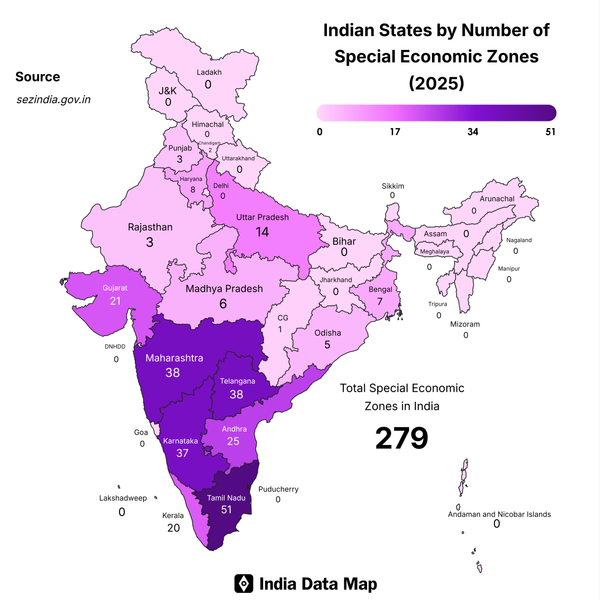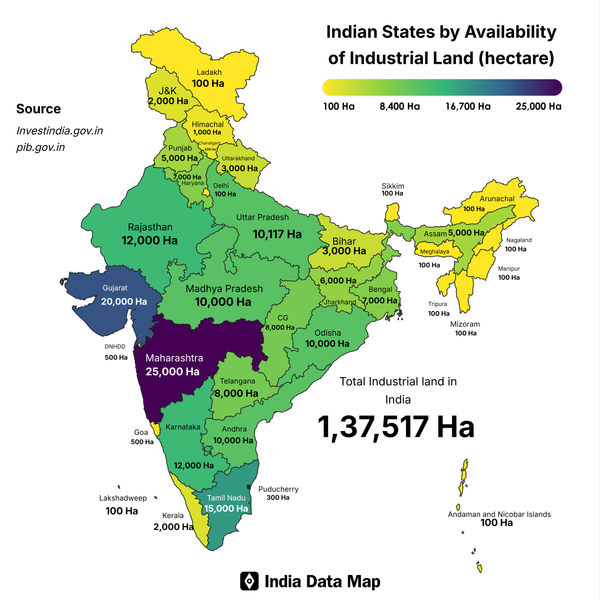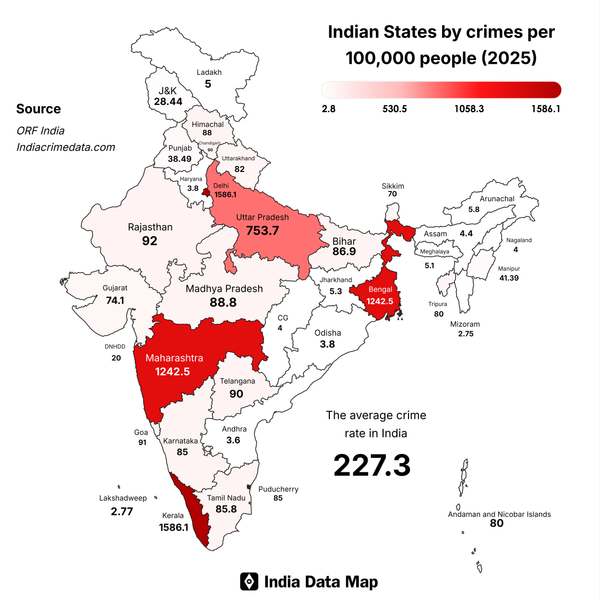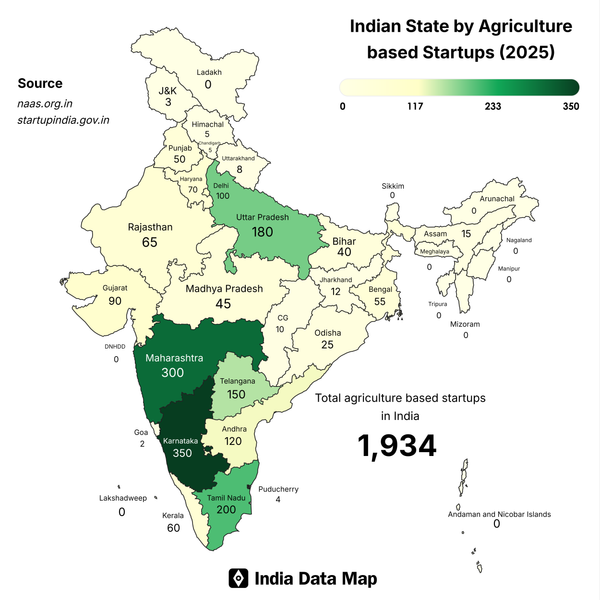Map: Indian States by Nuclear Energy Capacity (2025)
Explore India's nuclear energy landscape in 2025: Tamil Nadu leads with, while 30 states have zero capacity. Key insights and trends revealed!
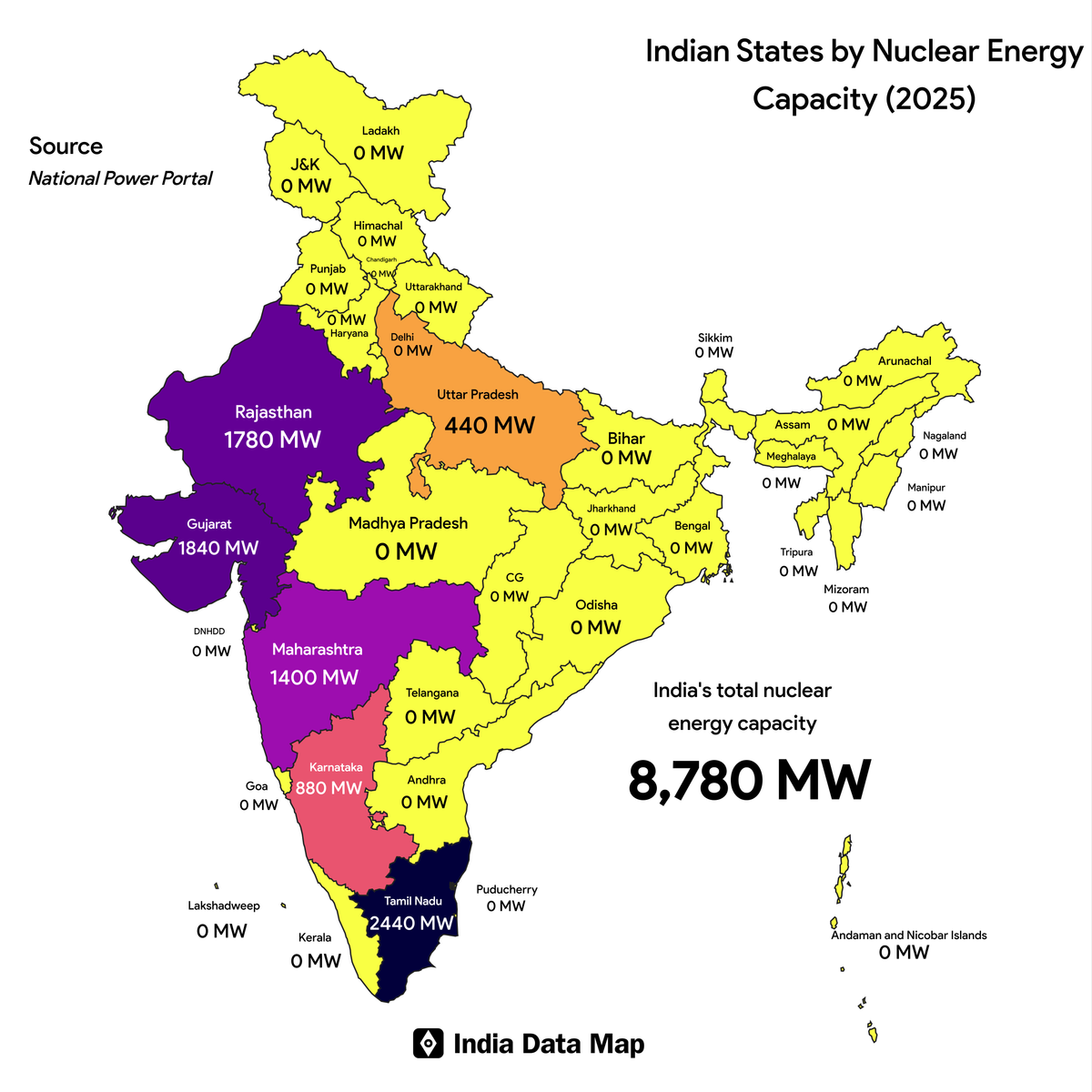
India's nuclear energy framework plays a vital role in its strategy for energy diversification, with nuclear power facilities primarily located in several important states.
According to the 2025 data regarding nuclear power capacity by state, the following are the significant facts and insights concerning the distribution of nuclear energy in India.
| Rank | State/Union Territory | Nuclear Power Capacity (MW) |
|---|---|---|
| 1 | Tamil Nadu | 2440 |
| 2 | Gujarat | 1840 |
| 3 | Rajasthan | 1780 |
| 4 | Maharashtra | 1400 |
| 5 | Karnataka | 880 |
| 6 | Uttar Pradesh | 440 |
| 7 | Andaman and Nicobar Islands | 0 |
| 8 | Andhra Pradesh | 0 |
| 9 | Arunachal Pradesh | 0 |
| 10 | Assam | 0 |
| 11 | Bihar | 0 |
| 12 | Chandigarh | 0 |
| 13 | Chhattisgarh | 0 |
| 14 | Dadra and Nagar Haveli and Daman and Diu | 0 |
| 15 | Delhi | 0 |
| 16 | Goa | 0 |
| 17 | Haryana | 0 |
| 18 | Himachal Pradesh | 0 |
| 19 | Jammu and Kashmir | 0 |
| 20 | Jharkhand | 0 |
| 21 | Kerala | 0 |
| 22 | Ladakh | 0 |
| 23 | Lakshadweep | 0 |
| 24 | Madhya Pradesh | 0 |
| 25 | Manipur | 0 |
| 26 | Meghalaya | 0 |
| 27 | Mizoram | 0 |
| 28 | Nagaland | 0 |
| 29 | Odisha | 0 |
| 30 | Puducherry | 0 |
| 31 | Punjab | 0 |
| 32 | Sikkim | 0 |
| 33 | Telangana | 0 |
| 34 | Tripura | 0 |
| 35 | Uttarakhand | 0 |
| 36 | West Bengal | 0 |
Key Facts
Tamil Nadu Leads the Way: Tamil Nadu is at the forefront with a nuclear power capacity of 2,440 MW, establishing itself as the largest contributor to India’s nuclear energy production.
This prominence is likely attributed to significant facilities such as the Madras Atomic Power Station and the Kudankulam Nuclear Power Plant.
Top Five States Dominate: The states of Tamil Nadu, Gujarat (1,840 MW), Rajasthan (1,780 MW), Maharashtra (1,400 MW), and Karnataka (880 MW) encompass the entirety of India’s nuclear power capacity. Collectively, these five states host all operational nuclear power plants across the nation.
Uttar Pradesh’s Emerging Role: Uttar Pradesh, with a capacity of 440 MW, is the only other state contributing to nuclear power capacity, although it falls considerably short compared to the top five states. This indicates a developing yet limited role of nuclear energy in northern India.
Zero Capacity in Most States: A notable finding is that 30 out of 36 states and union territories have no nuclear power capacity. This includes significant states such as Andhra Pradesh, Delhi, Kerala, and West Bengal, underscoring the concentrated nature of nuclear energy infrastructure.
Interesting Insights
Geographical Distribution: Nuclear power facilities are predominantly situated in the southern and western parts of India. Tamil Nadu, Gujarat, Maharashtra, and Karnataka—regions in the south or west—constitute over 80% of the overall capacity.
This concentration may be attributed to factors such as their proximity to coastal areas (which are essential for cooling water) and the presence of established industrial infrastructure.
Rajasthan’s Notable Contribution: Rajasthan, located in the north, emerges as a key player with a capacity of 1,780 MW, primarily due to the Rawatbhata Nuclear Power Plant. Its significance in a region that lacks extensive nuclear infrastructure is remarkable.
Absence in Major States: States with substantial populations and considerable energy requirements, including Bihar, West Bengal, and Andhra Pradesh, currently possess no nuclear power capacity. This situation prompts concerns regarding energy equity and the possibilities for future nuclear development in these areas.
Union Territories’ Absence of Capacity: All mentioned union territories, such as the Andaman and Nicobar Islands, Chandigarh, and Delhi, report zero nuclear capacity. This is anticipated, considering their smaller geographical size and the absence of appropriate infrastructure for nuclear power facilities.
Conclusion
In 2025, India's nuclear energy capacity is predominantly concentrated in a few states, with Tamil Nadu at the forefront, trailed by Gujarat and Rajasthan.
The lack of nuclear power in the majority of states and union territories highlights the difficulties associated with expanding nuclear infrastructure, such as significant costs, safety issues, and geographical constraints.
As India strives to fulfill its increasing energy requirements while minimizing carbon emissions, the significance of nuclear energy in states that currently lack capacity will be an essential subject for forthcoming energy policy deliberations.

